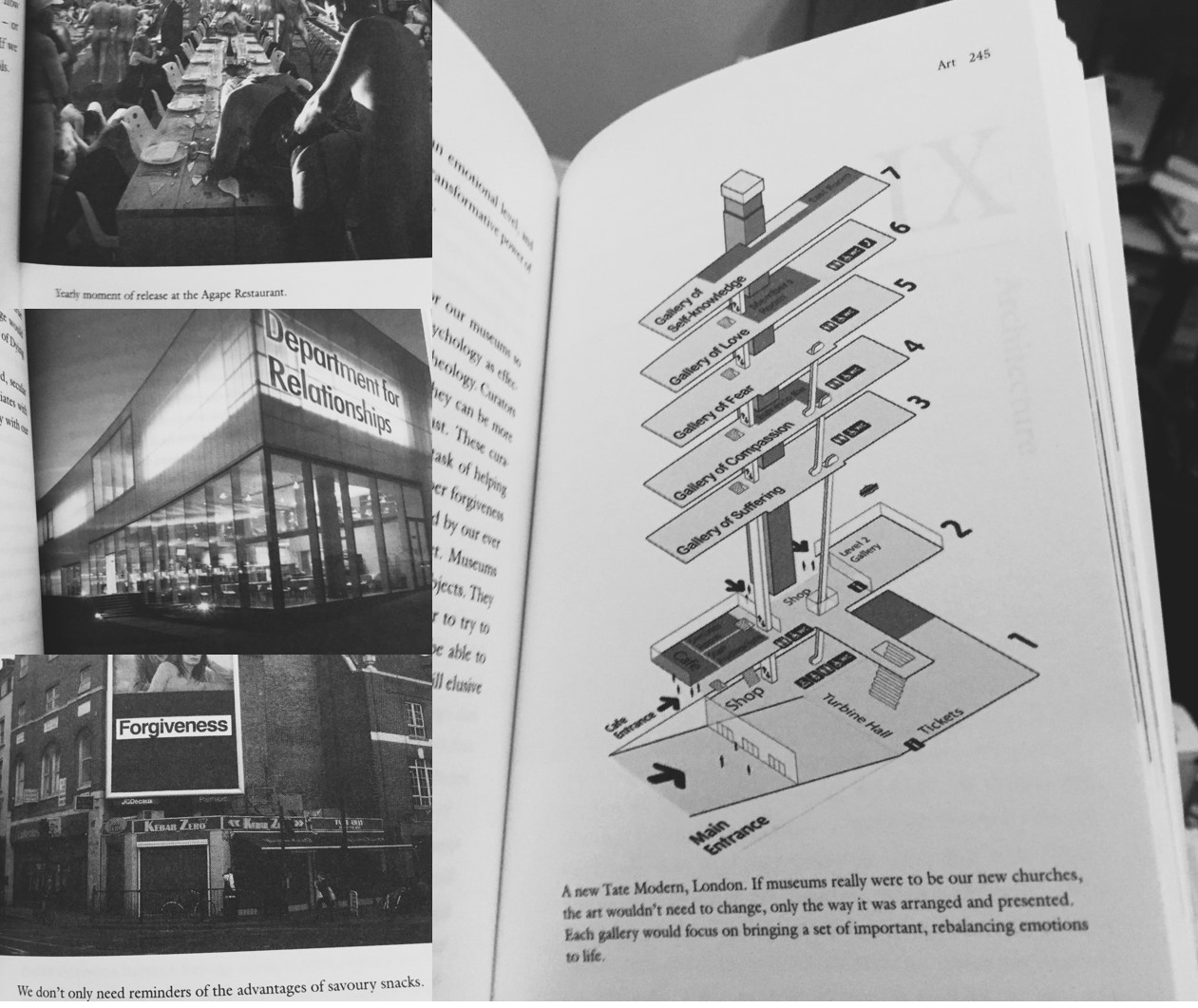
This was (IMHO 🙂) a rather lightweight contribution to Unit 7 of A113 on post-Revolutionary experimentation in religion, but I thought I'd just capture some of the suggestions de Botton makes about aspects of religious practice and ritual that might add to a wholly secular life.
They were:
'Community'
An 'Agape Restaurant' - an open door,all comers welcome venue where individuals are seated separately from any pre-existing relationships and take a meal. Whilst eating, conversation will follow a set of prescribed lines set out in a guidebook at the table - the 'Book of Agape' .... 'What do you regret?'...'Whom can you not forgive?'...'What do you fear?' - effectively forcing a deeper understanding of at least a few more of our fellow humans.
The link here is made chiefly with the Roman Catholic Mass, its foundation around the meal table and aspects of ritual that break down barriers between individuals and establish a new (if ?temporary) community. The conversation guidebook follows from aspects of the Jewish Passover ritual, where a fixed set of questions are asked by the youngest member of the family.
A quarterly Day of Atonement, where we seek out those we have harmed and apologise.
Simply a fourfold expansion of the Jewish ritual.
An annual Feast of Fools at the Agape Restaurant, where we have licence to be as irrational and sexually unfaithful as we like. In this way we acknowledge that maintaining a measured life is hard given our human drives and desires, giving vent to them may help us get through the rest of the year.
The stimulus here is the medieval Christian (?French) 'festum fatuorum' that took place on New Year's Eve when clerics were allowed to get up to all sorts of sacrilegious hijinks.
'Kindness'
Moral reminders on billboards and adverts and maintaining a tabletop pantheon of model moral role models.
The discussion here was around examples of religions being explicit about repeatedly reminding believers about how to live well, not expecting them to just get on with it. There were also plenty examples of requiring people to reflect on past 'heroes' and their achievements.
'Education'
The ideas here were mainly linked to higher education and a new role for it in accepting a role in teaching 'how to live'. There were a range of suggestions, making lectures into sermons, changing the focus of disciplines : Departments of Relationships; Institutes of Dying, Centres for Self-Knowledge, teaching teachers oratory so ideas would stick, engage with obstructions to acting on what you know - lots of repetition, using the body as part of the experience of education and training.
An interesting aspect of de Botton's argument was about the reasons subjects like art and literature entered the realm of University study - he makes a link with a 19thC crisis in confidence that religion could effectively deliver moral development and that 'Culture' was to be the remedy. However, he claims that whilst Universities seem to suggest they will 'develop' citizens they are not at all explicit about the moral messages that could be drawn from the arts. John Wesley gets a mention for delivering sermons that linked religion very much to the concerns of everyday life. Buddhism does most of the heavy lifting on training the body as a route to learning.

'Tenderness'
We should build Temples to Tenderness - calm soothing spaces, with images of motherhood.
The reflections here were how to respond to human dependence and religion's capacity to deliver on maternal comfort and support for everyone's inner (and ever present) child. Lots of Marian imagery here, but some other religions too, Guan Yin from Buddhism.
'Pessimism'
Share the bad thoughts, doubts and fears of ourselves and others on real time displays so we can recognise our darkness is shared - and weep together.
The immediate link was with the wailing wall - but with no divinity to address our concerns. The central argument is that religions accept that life is flawed, ugly and often/usually doesn't turn out right. Of course they often have other future lives on offer, but at least they do not promote an unfounded optimism about life. We should expect to be disappointed and to fail.
'Perspective'
Project images of distant galaxies to provide a perspective on the (un)importance of individual lives within the totality of the universe.
I liked de Botton's idea that religion was a symbol of what exceeds us.
'Art'
We should equip ourselves with instruction manuals on how to take life lessons from art, organise specific educational structures to the display of art - a set of 'stations of life', displays in galleries and museums should be reorganised around our moral needs.
A contrast is made between the way in which art is never without purpose or unexplained when it is displayed by religions, the 'stations of the cross' is an example of a structured contemplation of art in the Christian tradition.
'Architecture'
We should build Temples of Perspective (giant tower to represent time, with a fine line to show human existence), Temples of Reflection where we could contemplate in solitude.
There were multiple examples of how religions use the built environment to enhance their message, there was also an image from Pugin's 'Contrasts' where he was implying that ugliness might harm our souls.
'Institutions'
We need new, possibly corporate, institutions to promote secular values, develop brand identities, commodify atheism.
The examples here were all about the success and scale of the major religions as institutions/corporate bodies. How they have the advantage of scale, recognition and also major earning power.
Many of the salient points are made in this TED talk...